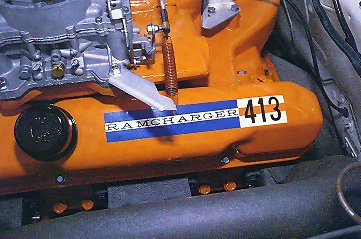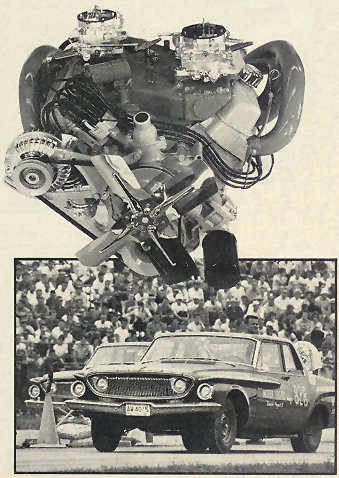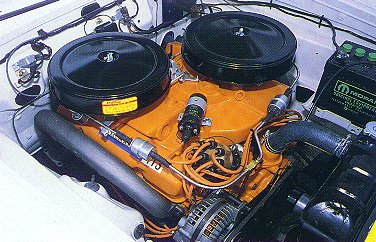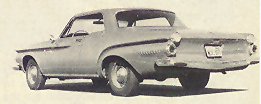1962 - 413 Cid Mopars
From an engineering standpoint,
Chrysler Corporation's maximum-performance horsepower hardware for
1962 was built into the most advanced new car offerings of all time.
Not only did they package their action in the lightest of all the
full-size vehicles available from the domestic auto makers, but
Chrysler also executed their offerings in the most radical fashion. |

|
And when you consider that the Corporation didn't
even offer a reasonably sized performance car before the '62 model run (their
413 engine had been available in only in the biggest and heaviest Chryslers
in the line), the release of the short-ram 413 wedge engine in Dodges and Plymouths
was truly a forward-looking move.
Built up around better
breathing for their biggest incher, the 413 engine block itself
received little special attention outside of main-cap hardness checks
and unique valve unshrouding notches cut into the top of each cylinder's
bore. Crankshaft, connecting rod and piston forgings were of the
highest grade available, while the long-duration solid-lifter camshaft
and the adjustable rocker train were already-proven pieces borrowed
from the well-tested Chrysler 300 letter-series line. The biggest
performance improvers, however, involved new cylinder head and manifolding
designs intended to move the maximum amount of air through a motor
in a given unit of time. |

|
The all-new race-oriented max-wedge heads had
25-percent-larger ports, a full 1/8-inch-bigger exhaust valves, reshaped intake
valves, stiffer dual valve springs, no heat passage to the intake manifold and
restructured deck surfaces for added clamping rigidity. Stainless steel head
gaskets were also included for improved head-to-deck sealing, forged 13.5:1
pistons, shot-peened rods, hard copper/lead main and rod bearings, high-volume
oil pump, baffled oil pan, and a completely new valve train with a solid-lifter,
300° camshaft. The only trouble with the dual valve springs was that valve-stem
seals wouldn't fit.
This resulted in '62 413s suffering from excessive oil consumption�as much as
a quart every 50 - 100 miles. Still, the owner's manual said the engine was
safe to 6500 rpm�but for sustained bursts not longer than 15 seconds.
To top things off, the
factory engineers developed a one-piece alloy intake manifold designed
to use air flow pulses to help fill the cylinders. The intake was
the unique short cross-ram Chrysler's cross-ram featured 15-in.-long
manifolds criss-crossing over the engine and big Carter AFB 4-barrels
mounted on integral plenum chambers above each valve cover. |

|
The layout was a natural evolution of the long-ram manifolds
Chrysler had used in the '60-'61 period. The internal runners' capacity, the
size and shape of the dual undercarb plenums and the location of the carbs on
the plenums were all resolved in a single compact casting specifically intended
to feed the '62 413's high-flow cylinder heads. Assists in the inlet system
were also provided by a multi-valved high-pressure fuel pump and by unsilenced,
low-restriction air cleaners for the twin Carter AFB carbs. The new cross-ram
aluminum manifolds were good for an extra 10-15 HP.
The all-new upswept exhaust manifolds were also
quite exotic in appearance. Huge iron castings looped up over the fenderwells
to carry individual passages back to big 3-in. headpipes and all indications
were that the large-capacity tuned castings were every bit as effective as they
looked.
Huge iron castings
looped up over the fenderwells to carry individual passages back
to big 3-in. headpipes. There truly was nothing else like them in
the industry.
|

|
Breathing efficiency was further enhanced by
what, to this day, amounts to the most complete street and strip exhaust system
ever installed on any assembly-line automobile. The headpipes were designed
with dump tubes that could be quickly uncapped for street or strip racing. a
balance tube connecting the headpipes helped to quiet down and to tune up the
waste flow. Backed by dualhigh-capacity New Yorker mufflers, the system efficiently
terminated in full-length, 2-inch tail-pipes. The system was so efficient that
the engine lost only 30�40 HP with the dump tubes capped!
The headpipes were designed
with dump tubes that could be quickly uncapped for street or strip
racing. a balance tube connecting the headpipes helped to quiet
down and to tune up the waste flow. |

|
There were two horsepower versions of the 1962- 413 cubic
inch engines.
One with 11.0 to 1 compression ratio rated
at 410 Hp @ 5400 rpm. and the
other a whopping 13.5 to 1 rated at 420 Hp
@ 5400 rpm.
The 413-engined "Ramcharger"
Dodge and "Super Stock" Plymouth packages also included
extra-duty running gear and standard-style high-performance support
equipment for all (suspension, fuel, cooling, electrical and lubrication)
on-board systems. |

|
How Fast Were They ???
Reported performances include a showroom-stock
clocking of 14.4 at 101 mph for a 3440-pound, 3.91:1-geared, street-tired Dodge
that was also equipped with an optional automatic transmission. Chrysler's three-speed Torqueflite was the only non-standard-shift
factory trans ever fitted to an assembly-line super stocker, and what's more,
gear changes with this unit were made by simply pushing a button! Using a pair
of sticky Atlas Bucron tires, this same car, running with the exhaust cutouts
open, clocked a 13.44 quarter at 109.76 mph. A 4.56:1-geared manual trans version
of the 413 Dodge used basic strip tuning, tubing headers and 7-inch-wide M&H
race tires to record a quarter-mile test best of 12.97 at almost 114 mph.
The 413's performances regularly put it into the winners' circles in both straightaway
and speedway action.
Copyright © 1999 Bruce Cresswell





